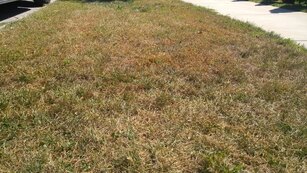 Overseeding your lawn is a really important part of having a thicker, healthier and greener lawn with less weeds. It really isn't difficult to do, but it does require some knowledge to get the most germination for your buck. Read on to learn the why, what, how, when and where of overseeding your lawn. Keep in mind, we're a West Michigan-based company, so our recommendations are targeted for this region. Why should you overseed your lawn? Nature loves diversity. On the flip side, it hates a monoculture. Our efforts, as 21st century American homeowners, to create a monoculture in our lawns goes directly against what nature wants. So, left to its own devices, your lawn is going to have a lot of diversity popping up. You might better know this diversity as "weeds." You don't want weeds (and you don't want to use herbicides)? Put down grass seed and over time, it will push out the weeds. Now you've got three options when facing the idea of lawn diversity: 1) Let it happen. Just unconditionally accept the diversity popping up in your lawn and love it as you would love a pasture growing wild in the countryside. 2) Drop chemical herbicides onto it. This is how golf courses and baseball fields roll. They put down chemical herbicides to both prevent and kill weeds. It's also how most Americans have been conditioned by the chemical lawn industry to approach their lawns. ("Weeds are BAD!") Or (our favorite choice) 3) Employ better lawn management practices. This means fertilizing with an organic fertilizer to get richer soil that turf actually wants to grow in. It means watering deeply a couple times a week to encourage deeper roots. It means setting your mower to its highest setting. And it means overseeding your lawn once, and maybe even twice, every single year. The importance of overseeding comes from the fact that weed seeds can find even the smallest gap in your lawn to germinate and establish roots. If you can put down grass seed before the weed seeds can germinate, you'll have grass growing there instead of something you don't want Now, if you're going to opt for an organic lawn, you're going to have to accept Option 1 to a certain degree. Going organic, you should always expect (and even strive for), at minimum, 10% diversity in your lawn. Anything less than that just isn't healthy. If your lawn is more than 90% grass, you're opening yourself up to pest infestation, fungal infection, higher water bills, etc. But allowing some other stuff (clover, dandelions, violets, etc.) to find a home on your lawn will help keep things balanced and healthy. And telling yourself that some diversity is good for your lawn will even help you relax a bit and enjoy your lawn more, without the stress of striving for perfection weighing you down all summer. I only recommend Option 2 (chemical herbicides) as a very last resort, and as an organic lawn guy, I don't make specific chemical recommendations. But if your yard has become more than 50% weeds, and you're not happy with how it looks, I'd advise researching ways to start over by killing off what's there, and doing a complete re-seed or re-sod. If you've just got areas that are becoming infested with weeds (creeping charlie, for instance), at the very most, spot treat with an herbicide to kill of the stuff in that area, then re-seed. Again, these are last resorts in my opinion. Pulling up weeds and overseeding is a much more sustainable option But keeping weeds out isn't the only reason you should overseed. Does your lawn do better in certain parts of your yard than others? Maybe your shady backyard is thick and lush, while your sunny front yard is looking thin and brown during the hot summer months. Maybe the grass under the shade of a tree looks good, while the grass that doesn't receive shade looks terrible. If so, there's a chance your yard was initially seeded or sodded with the wrong type of grass. If a shade-loving grass was put down in an area that never gets shade, it's always going to struggle. Likewise, if a sun-loving grass gets put in a shady area, it's not going to thrive either. So what's a homeowner to do to fix this sun/shade problem? Overseed with a sun/shade grass seed mix.
0 Comments
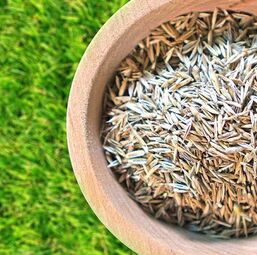 I've seen a lot of yards that have great looking turf in one part (maybe the backyard), but struggle to make grass grow in others (perhaps the front). The homeowner is doing the same thing across their entire yard (same mowing practices, watering practices, fertilization, etc), so why does one part of the yard continue to struggle while another thrives? It probably has to do with the type of grass that was originally put in. Does this situation sound like your yard? Thick turf in one area, weak turf in another? There's a good chance you've also got the wrong type of grass in one part of your yard. Next time you're in your yard, look up. In the weak-turf area, is it a sunny area with very little shade? Chances are your yard was seeded or sodded with a shade-loving turfgrass. Or maybe the weak part of your turf is in a shady area. Chances are it was seeded or sodded with a sun-loving turfgrass. So as a homeowner trying to grow thick healthy grass in ALL parts of your yard, are you supposed to research different types of grass seed, know the sun tolerance of each type of grass, and then calculate the amount of sunlight each part of your yard receives? Nope, it's not going to that complicated. Our recommendation for people looking to thicken up their turf by overseeding is to buy a sun/shade seed mix. You overseed your lawn with a sun/shade mix, and you just let nature sort out what grows where. The sun-loving seed with thrive in the sunny areas, the shade-loving seed will thrive in the shady areas, and you will be a happy homeowner with a thicker turf in all parts of your yard. We sell a great uncoated (no chemical coating) sun/shade grass seed mix, and will deliver it for free anywhere in Kent, Ottawa, Allegan and Muskegon Counties. We've been using this mix for years with great results. Have questions? Email Steve at [email protected]. Another option is clover. Dutch White Clover is a great groundcover that tolerates both sun and shade, fills in bare spots nicely where turf often struggles, stays green all summer long, grows at the same rate and height as turfgrass, and is good in high-traffic areas. We sell clover seed too! 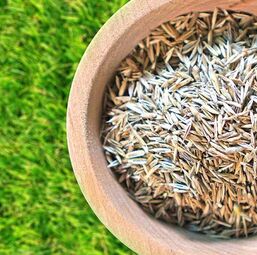 Having a healthy and attractive lawn isn't really a "set it and forget it" operation. There's mowing, watering, fertilizing, and then there are other optional tasks like aerating, weeding and de-thatching. But one relatively easy task many homeowners overlook when it comes to the health of their lawn is overseeding. Lawns can take a beating over the course of a year: pets doing their business, kids playing, high foot traffic, drought, squirrels digging, ice-melt run-off in the winter, and more. Turf can thin out over the course of a year, just from normal wear-and-tear. That wear-and-tear can cause gaps in your lawn, and those gaps can make your yard look worn. Even worse, those gaps are where weeds pop up! Nature hates empty space. If you've got a gap on your lawn-- even a nickel-sized gap-- something's going to pop up there: crabgrass, Canada thistle, dandelions, chickweed, or other annoying plants. Now, I'm not opposed to some diversity in a lawn, but too much can make a lawn look ragged. The best way to combat those weeds naturally is to take away the space where they're most likely to germinate, and the best way to do that is to overseed with a sun/shade grass seed every late-summer or fall (September-October). You can also overseed in the spring (April to early-May), but your grass seed will be competing for space, water and nutrients with weed seeds. Really the only time you shouldn't overseed is summer (late-May-August) and winter (November-March). Good Sweet Earth sells an uncoated sun/shade grass seed perfect for overseeding in Michigan (and other cool-temp grass zones). For areas where you struggle to get grass to thrive, we have an all-natural soil amendment called Lawn Soil, especially blended to help grass seed germinate and grow strong in its first month of life. If you'd like to save a ton of money on grass seed, consider joining our Seed Club. You pay a one-time membership fee, and you're a member for life. Once you join you can save 50% (Gold Membership) or 10% (Green Membership) on all yard seed purchases with Good Sweet Earth for the rest of your life! 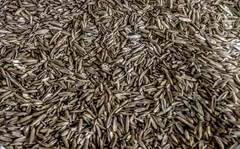 If there's one thing homeowners can do to get their lawn thicker and less weedy, it's over-seeding in the late-summer/early fall. Spring is another good time to over-seed, but August and September really are the ideal time. Most weeds in our lawns are perennial weeds, so as the growing season comes to a close, they die out. That means there's going to be some openings in your lawn for something to germinate there in the spring. If you put down some grass seed in August or September, those seeds will germinate before winter, and come spring, there will be fewer spots for weeds pop up. For even application, it helps to have a spreader, but you can distribute the seed by hand too. When customers ask what type of seed we recommend, 9 times out of 10, we tell them to get a sun/shade mixture. This means, no matter how much sun each part of your yard receives at any given point in the day, the right grass will germinate there and flourish. I've seen more than my share of lawns that have thick, healthy grass under a tree, while the rest of the lawn looks sparse and weak. Chances are, only one type of grass was planted in this yard initially (a shade grass), and the parts of the yard that receive a lot of sun just can't thrive. Over-seeding with a sun/shade blend will help with that. Over the past few years, we've tried out various grass seed mixes, and we've found one that we really like. The seeds are uncoated (no synthetic chemical coating), establish nicely when watered properly, and fill in the gaps very well. So instead of just recommending a grass seed, we're now selling it. There's no need to buy more than you'll use-- we'll help you figure out exactly how much you need, and you can purchase that amount. When you click here, there's a yard measurement tool that you can use to figure out the size of the area you're over-seeding. Then, once you have a number, you can purchase the amount of seed you need for that space. Live in West Michigan? We offer free delivery anywhere in Kent, Ottawa, Allegan or Muskegon Counties. Live outside of our delivery area? We ship! Got questions? Feel free to email our lawn guy Steve at [email protected] Interested in White Dutch Clover seed? We've got that too. Looking for Worm Compost? Here's the link to our specialty vermicompost. 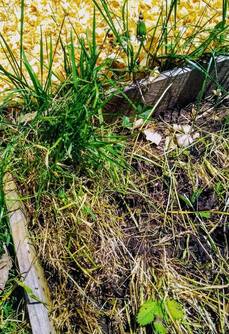 You ever notice grass growing in your garden? Or in a flower bed? It can be downright tenacious. It grows, it spreads, and left unchecked for a few weeks, it can just overwhelm the area. Grass is essentially an aggressive weed when it grows in the wrong place. Do you know why grass aggressively infiltrates your garden and flower space? It's because most of us work really hard to give our tomatoes and peppers and marigolds and petunias and basil plants healthy soil. It's that healthy soil that draws the grass in. So now let me ask you: Does it grow tenaciously in your lawn? Or is it thinner than you'd like? Are there bare spots? Are there spots in your lawn where other things have taken over and the grass is just non-existent? If so, you're not alone. The problem is that we focus on creating healthy soil for our garden beds and flower beds (with mulch and compost and other soil amendments), but then just don't think about the soil under our grass. And then we wonder why grass grows tenaciously in our gardens, which has soil chock full of organic matter, but there are bald and weak spots all over our lawn. Getting healthy soil under your lawn isn't something that you can fix by dumping on synthetic chemicals (like Scotts). To get that nice healthy tenacious grass, you need to put as much attention into getting organic matter into your lawn's soil as you do with your garden's soil. How do you do that? With organic fertilizer and topdressing. Getting more organic matter into your soil is critically important for your turf. Our fertilization service includes an Alfalfa Blend Fertilizer to do just that (a blend of alfalfa meal, spent distillers grains & kelp). But you can also DIY by topdressing with compost, or fertilizing with something like alfalfa pellets (40 pounds per 1000 square feet of turf), or Purely Organic Lawn Food (25 pounds per 5000 square feet of turf) or our own Alfalfa Blend Lawn Fertilizer (35 pounds per 5000 square feet). Topdressing and/or fertilizing should be done twice a year, in spring (April/May) and late summer (late August to mid September). You want to build up the soil and get those nutrients down just before the grass's growing season starts, which in Michigan is spring and fall. If you've got questions about adding organic matter to your lawn, or are interested in learning more about our organic lawn fertilization, shoot me an email at [email protected] |
